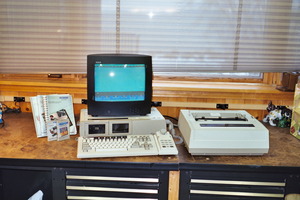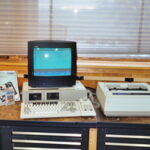Many teens in the 80’s grew up with computers like the Atari 400, Atari 800, Commodore Vic-20, Commodore 64, Texas Instruments TI-99/4A or Apple II, they were the mainstream personal computers of the era. However, my family chose a different route. We bought the Coleco ADAM as our first home computer. There were many good reasons why we bought an ADAM. However, we discovered a few drawbacks to the machine and traveled the lonely road of owning an orphaned product.
The built in daisy wheel printer was one of the ADAM’s most compelling features. was both a blessing and a curse. While it produced brilliant looking papers compared with the poor quality perforated mess produced by the its dot matrix competitors, the ADAM’s printer may have the singular distinction of being the loudest computer printer ever produced by humanity. If you were printing out a school paper everyone in your home would know. The ADAM printer was also very slow. It printed 10 or 11 characters per second. By my recollection, dot matrix printers of the era were printing 60 to 80 characters per second. Since the ADAM printer was faster than we could type, our family thought it was an improvement.
My Coleco ADAM’s first papers were well received at the high school level, but relying on the clackety daisy wheel was disastrous when I was away at college. On one of my very first papers, the letter “e” broke off on the daisy wheel. I searched all over Gainesville, Florida, looking for a replacement before giving up and hand lettering every instance of the required vowel into my paper. By 1987, the Coleco ADAM was already an orphan. I had no idea which daisy wheel would be an adequate replacement for the original equipment wheel.
After losing another paper due to a power failure, I switched to doing all my papers on campus in a computer lab. Floppies were safer than ADAM SmartDRIVE tapes and the dozens of computers in a college lab gave me plenty of backup systems in the event of a problem. Unfortunately, I couldn’t trust “mission critical” papers to an orphan computer. The ADAM was supported under warranty for some period of time by Honeywell. When we had a problem, we took the machine in to a service center and it was repaired. However, we were fortunate to live in a major city near one of the service centers. Packing an ADAM up in its original packaging and sending it off via UPS would probably not have been a trivial exercise back in the late 80s.
The late 80s and early 90s were exciting times for computer users. By the time I graduated college, I had left the Coleco ADAM behind and moved on to IBM PCs. However, the ADAM still has fans. Even now, Coleco ADAM user groups have extended the capabilities of their machines and can make this vintage computer do amazing things.
Sources:
Personal Experience
Other articles by this contributor:
Retro Game System Review: Super Nintendo Entertainment System
Four Useful Retro Tools for Writers
Vintage Camera Review: Canon AF35M II SureShot Autoboy 2 35mm Film Camera





